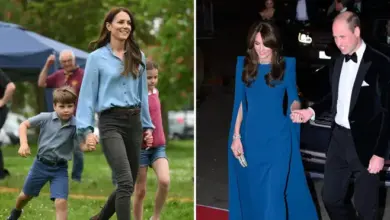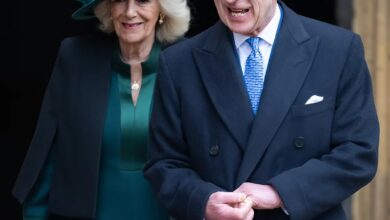The Diana Connection: How Kate Middleton’s Marriage to ‘Headstrong’ Prince William Thrives
Kate Middleton's marriage to Prince William has captivated the world's attention since their wedding in 2011. As the couple navigates the complexities of royal


Kate Middleton’s marriage to Prince William has captivated the world’s attention since their wedding in 2011. As the couple navigates the complexities of royal life, many have drawn comparisons between Kate and her late mother-in-law, Princess Diana. However, a new book by Robert Jobson titled “Catherine, The Princess of Wales” sheds light on how Kate’s unique qualities and background have contributed to the success of her marriage to the “headstrong” Prince William. This article explores the dynamics of their relationship, the influence of their respective upbringings, and the ways in which Kate has carved out her own role within the royal family.
The Early Years: Kate and William’s Courtship

Meeting at St. Andrews University
Kate Middleton and Prince William’s love story began in the hallowed halls of St. Andrews University in Scotland. The two met in 2001 when they were both studying art history. Initially friends, their relationship blossomed over time, with Kate catching William’s eye during a charity fashion show where she famously wore a sheer dress.
Their time at university allowed them to get to know each other away from the intense scrutiny of the public eye. This period was crucial in laying the foundation for their future relationship, as they were able to interact as normal students rather than as a prince and his potential future bride.
The privacy afforded to them at St. Andrews was instrumental in allowing their relationship to develop naturally. They shared a house with friends, attended classes together, and participated in typical university activities, all of which helped to cement their bond.
The On-and-Off Relationship
Like many young couples, Kate and William’s relationship wasn’t always smooth sailing. They experienced a brief breakup in 2007, which became fodder for tabloid headlines. However, this separation proved to be a turning point in their relationship.

During their time apart, both Kate and William had the opportunity to reflect on their feelings and priorities. Kate demonstrated her resilience and independence during this period, focusing on her career and personal growth. This time apart ultimately strengthened their relationship, as they realized the depth of their feelings for each other.
Their reconciliation was met with joy by royal watchers, who saw in Kate a stabilizing influence for the young prince. The couple’s ability to weather this storm and emerge stronger was an early indication of the strength of their bond.
The Engagement and Royal Wedding
After years of speculation and the nickname “Waity Katie” bestowed upon her by the press, Kate’s patience was rewarded when William proposed during a trip to Kenya in 2010. The engagement was a momentous occasion, not least because William presented Kate with his mother’s sapphire and diamond engagement ring.
The significance of this gesture was not lost on the public or the royal family. It symbolized a connection between Kate and the beloved Princess Diana, while also representing William’s desire to include his mother’s memory in this important milestone.
The royal wedding on April 29, 2011, was a global spectacle, watched by millions around the world. Kate’s grace and poise during the ceremony and subsequent appearances endeared her to the public and set the tone for her future role as a member of the royal family.
The Diana Factor: Comparisons and Contrasts

The Weight of Legacy
From the moment Kate Middleton entered the royal spotlight, comparisons to Princess Diana were inevitable. Both women married the heir to the British throne and were thrust into a level of public scrutiny few can comprehend. However, the circumstances and personalities of these two women differ significantly.
Kate was well aware that marrying Prince William meant following in Diana’s footsteps to some extent. The public and media’s fascination with Diana’s legacy meant that Kate’s every move would be analyzed and compared to her late mother-in-law. This pressure could have been overwhelming, but Kate has navigated it with remarkable composure.
Unlike Diana, who was just 20 when she married Prince Charles, Kate was 29 at the time of her wedding. This age difference, combined with her years of experience dating William, gave Kate a more mature perspective on what royal life would entail.

Different Backgrounds, Different Approaches
One of the most significant differences between Kate and Diana lies in their upbringings. Diana came from an aristocratic background but experienced the turmoil of her parents’ divorce. In contrast, Kate grew up in a stable, middle-class family, which provided her with a strong foundation of security and support.
This difference in background has had a profound impact on how each woman approached her role within the royal family. Diana, often described as emotionally volatile, struggled with the constraints and expectations of royal life. Kate, on the other hand, has demonstrated a remarkable ability to adapt to her role while maintaining her composure.
Kate’s stable upbringing has given her the emotional tools to handle the pressures of royal life. Her close-knit family has remained a source of support throughout her journey, providing a sense of normalcy amidst the extraordinary circumstances of her position.
Public Perception and Media Handling
Both Kate and Diana have been subject to intense media scrutiny, but their approaches to handling this attention have differed. Diana’s relationship with the media was complex, alternating between using it to her advantage and feeling hounded by paparazzi.
Kate has taken a more measured approach to media relations. She and William have been proactive in managing their public image, carefully controlling the flow of information about their private lives. This strategy has helped them maintain a degree of privacy while still fulfilling their public duties.
While Diana was known for her emotional openness and tactile nature in public appearances, Kate has adopted a more reserved demeanor. This approach has allowed her to maintain a sense of dignity and professionalism in her role, while still connecting with the public in a meaningful way.
Kate’s Calming Influence on William

Balancing William’s ‘Headstrong’ Nature
Robert Jobson’s book reveals that Prince William has inherited some of his mother’s headstrong and emotional traits. This characteristic could potentially lead to conflicts within the royal family and in his public role. However, Kate’s calming presence has been





